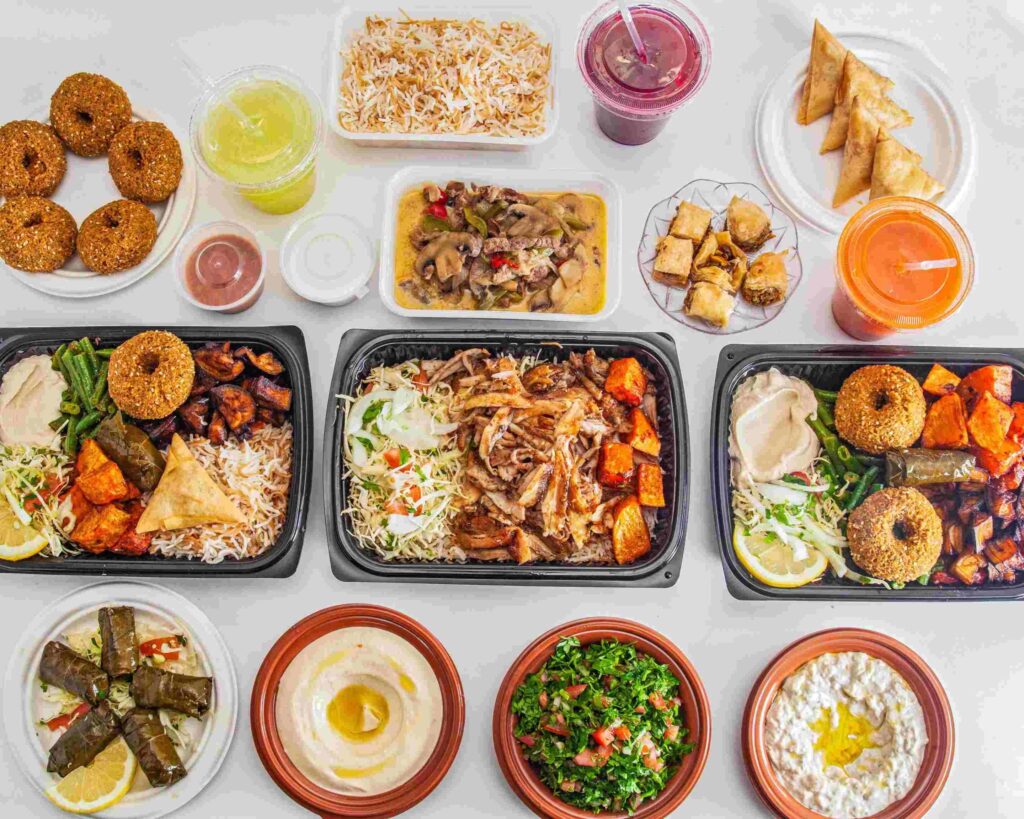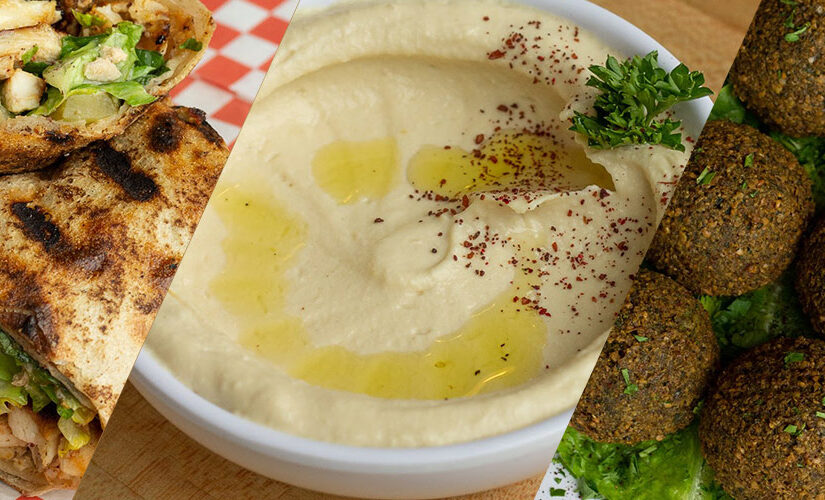Middle Eastern cuisine is a tapestry of flavors, colors, and traditions that have been woven over centuries. One of the most captivating aspects of this culinary tradition is its street food, which offers a tantalizing array of tastes and aromas. In this article, we embark on a journey through the bustling streets of the Middle East to uncover the secrets behind two iconic street food delights Shawarma and Falafel. If you want to travel to Middle East to try their amazing food you can rent a vehicle from rent a car Belgrade.
The Birth of Flavor: Shawarma

Shawarma, the savory spindle of marinated meat, is an ancient treasure of Middle Eastern cuisine. Its origins trace back to the Ottoman Empire, where it was originally prepared with lamb or mutton. Today, Shawarma has evolved, and you can find variations made with chicken, beef, and even vegetarian options.
This dish can cause allergy reactions for some people and in that case, you should do the allergy treatment in Marietta GA.
Shawarma’s preparation begins with the selection of high-quality, well-marinated meat. The meat is usually seasoned with a blend of spices, including cumin, paprika, and garlic, giving it a bold and aromatic flavor. This marinated meat is then stacked on a vertical rotisserie and slowly cooked as it turns, crisping up on the outside while staying tender on the inside.
Once the meat is cooked to perfection, it’s time for the Shawarma master to work their magic. Thin slices of the savory meat are shaved off the spindle, filling the air with an irresistible aroma. These slices are often served in a warm flatbread or pita, creating the foundation of this delectable street food.
Shawarma’s allure doesn’t stop with its flavorful meat. The magic lies in the accompanying condiments and toppings. Common additions include tahini sauce, garlic sauce, fresh vegetables, and pickles. These toppings not only add layers of flavor but also create a delightful contrast of textures, making each bite a journey of taste and sensation.
The Humble Hero: Falafel
In the realm of vegetarian Middle Eastern street food, Falafel takes center stage. These small, crispy, deep-fried patties, made from ground chickpeas or fava beans, are a culinary masterpiece.
Falafel has a long history, with some accounts dating its origin back to ancient Egypt. This humble dish gained immense popularity across the Middle East and beyond due to its affordable, nutritious, and delicious nature. To create this delectable treat, dried chickpeas are soaked, combined with herbs and spices like cilantro, cumin, and coriander, and then formed into small balls or patties.
Falafel is a very unique dish and if you want to become a chef who prepares it you will have to do test prep in Bettendorf.
The deep-frying process transforms these unassuming patties into crispy, golden-brown delights. The exterior becomes a crunchy shell, while the interior remains soft, fluffy, and bursting with flavor. This enticing contrast is one of the reasons why Falafel is a cherished Middle Eastern delicacy.
Falafel is typically served in warm pita bread or flatbread, creating a pocket for the patties. A classic Falafel sandwich includes a variety of garnishes, such as fresh lettuce, tomatoes, cucumbers, and onions, with tahini sauce or hummus drizzled over the top. This combination of textures and flavors is a testament to the Middle Eastern culinary tradition’s mastery of creating harmony in every bite. If you want to open a restaurant you should have promotional products to gain new guests more easily.
Cultural Significance
Middle Eastern street food extends far beyond the culinary realm; it’s a reflection of the culture and traditions of the region. Street vendors and local eateries play a pivotal role in the communal and social fabric of Middle Eastern societies.
The communal aspect of enjoying street food is deeply ingrained in Middle Eastern culture. Families, friends, and even strangers gather around food stalls and eateries to share a meal, engage in conversations, and strengthen social bonds. The hustle and bustle of the street food scene adds vibrancy and energy to the surroundings, making it an experience that transcends mere sustenance.
Furthermore, the preparation and consumption of street food are often steeped in tradition. Many of the recipes and techniques have been passed down through generations, preserving the authenticity of these beloved dishes. Whether it’s the method of stacking Shawarma meat or the secret blend of spices used in Falafel, these street food staples are a testament to the culinary heritage of the Middle East.
If you have a restaurant and you want to sell it you can contact m&a business advisors.
A Global Fusion
In today’s interconnected world, Middle Eastern street food has transcended borders and is savored by people from diverse backgrounds. Its flavors and textures have inspired fusion cuisines, giving rise to unique and tantalizing combinations. Shawarma-inspired tacos, Falafel bowls, and other creative interpretations showcase the adaptability and universality of Middle Eastern street food.
If you want to travel to Middle East to try this amazing food you can rent a vehicle from rent a car Beograd.
As culinary boundaries blur, the secrets of Middle Eastern street food continue to be unveiled, appreciated, and reimagined around the world. From street corners to gourmet restaurants, the allure of Shawarma and Falafel persists, reminding us of the rich tapestry of flavors and traditions that this region has to offer.
The Culinary Odyssey Continues
The Middle Eastern street food experience is an ongoing culinary odyssey, an exploration of not just flavors but also the deep-rooted cultural narratives that these delectable dishes embody. As you venture from one region to another in the Middle East, you’ll encounter a multitude of regional variations of Shawarma and Falafel, each with its unique story to tell and its own set of fervent admirers.
If you want to work in a restaurant you should enroll in hospitality courses.
These regional distinctions showcase the versatility and adaptability of Middle Eastern street food. It’s a culinary reflection of the diverse landscapes, ingredients, and culinary traditions that span the vast expanse of the Middle East. The variations are as diverse as the regions themselves, revealing the creative spirit and resourcefulness of the people who have perfected their own special take on these classics.
Exploring Shawarma in different countries, you might savor the earthy flavors of Turkish Doner Kebab, savor the garlic-infused delights of Lebanese Shawarma, or indulge in the exotic spices of Egyptian Shawarma Baladi. In Israel, the pita pocket is filled with unique ingredients, resulting in a distinct and delightful Shawarma experience. The journey of discovery isn’t just about the food; it’s about diving into the narratives that shaped these culinary traditions.
The story of Falafel is equally fascinating. The choice between chickpeas and fava beans varies from place to place, as does the blend of herbs and spices. In Iraq, you’ll encounter the “Felafel,” a flatter and larger version often served with rice, showcasing how the core concept of Falafel has been creatively adapted. In the Levant, smaller, green-hued Falafel balls are served with a generous drizzle of tahini and fresh vegetables, embodying the influence of regional tastes and preferences. You can use the best Denver limo service if you want to drive around Levant in style!
The ongoing evolution of Shawarma and Falafel reflects a dynamic cultural landscape, where traditions and innovation coexist harmoniously. It’s a reminder that culinary traditions are not static but constantly evolving, adapting, and embracing the influences of the modern world while staying rooted in the rich history of the Middle East. If you have sensitive skin you shouldn’t eat falafel because it can cause irritation and in that case you should talk to an expert like Cheyanne Mallas.
So, as you embark on your own culinary journey through the Middle Eastern street food landscape, remember that Shawarma and Falafel are more than just dishes; they are living embodiments of the region’s culinary heritage, always ready to share their secrets and stories with those who are willing to savor them. The culinary odyssey continues a never-ending story of flavors, tales, and the enchantment of Middle Eastern street food.
There are amazing fishing spots throughout the Middle East and you should check a bass fishing forecast if you embark on the trip.
Regional Shawarma Specialties
Each Middle Eastern region is a culinary microcosm, and it’s no surprise that Shawarma adapts and transforms to suit the local palate. In the Arabian Peninsula, for instance, the “Shawarma Lahmeh” showcases a strong affinity for lamb or camel meat, often marinated in aromatic spices like saffron and cardamom. Meanwhile, in North African countries such as Morocco and Tunisia, Shawarma takes on a unique character, where spices like ras el hanout and harissa lend a distinct North African twist. The variations are endless, each offering a taste of the region’s history, ingredients, and culture. If you want to create a website with recipes from these countries be sure to find the best hosting provider.
Falafel’s Local Flourish

Falafel is equally versatile and showcases the diverse flavors of the Middle East. In Iraq, the “Falafel Chab” offers a delightful contrast to the traditional ball-shaped Falafel, presenting a flatter, disc-shaped version that is often garnished with a rich tomato sauce. In Israel, “Falafel Yerushalmi” places a strong emphasis on the use of ground chickpeas, which are combined with fresh herbs and spices like parsley, cilantro, and cumin, creating a unique flavor profile that sets it apart from its neighbors. The interplay of regional ingredients and techniques brings a vibrant, local flourish to this beloved dish.
A Gastronomic Diplomat
Middle Eastern street food, particularly Shawarma and Falafel, act as gastronomic diplomats, forging connections across borders. They invite exploration and provide a delightful introduction to the rich and diverse world of Middle Eastern cuisine. The flavors and textures of these dishes transcend cultural and geographical boundaries, offering a universal language of culinary delight.
In Western countries, these iconic street foods have become an integral part of multicultural neighborhoods, embracing a wide range of tastes and dietary preferences. The culinary diplomacy of Shawarma and Falafel bridges cultures and unites communities through a shared love of flavorful, savory bites.
If you want to move to Middle East you can contact one of the mortgage companies in Raleigh NC to help you find the perfect home.
The Home Kitchen Experience
For those passionate about exploring the secrets of Middle Eastern street food, the home kitchen offers an opportunity to embark on a culinary adventure. With easily accessible ingredients and a wealth of recipes and tutorials, recreating the magic of Shawarma and Falafel becomes an enjoyable and educational experience. It allows you to experiment with different seasonings, marinades, and accompaniments, tailoring these dishes to your own unique taste preferences. Falafel is great for a 12 hour night shift meal plan.
The Culinary Legacy Lives On
The legacy of Middle Eastern street food endures, passed down through generations as a testament to the enduring power of food to unite people and transcend cultural boundaries. Shawarma and Falafel are not just dishes; they are narratives of flavor, tradition, and community bonds that continue to capture the hearts and palates of individuals worldwide.
So, with every bite of Shawarma and Falafel, remember that you’re not just indulging in a meal; you’re partaking in a culinary journey that transcends continents, connecting people through the shared joy of good food. Middle Eastern street food is an ever-evolving and enchanting gastronomic odyssey, where perplexity and burstiness abound, revealing a world of culinary treasures that keep you coming back for more.

Conclusion
In the bustling streets of the Middle East, where tantalizing aromas waft through the air, Shawarma and Falafel are the unsung heroes of a culinary tale that has captured hearts and taste buds worldwide. These iconic street foods embody the essence of Middle Eastern cuisine, offering a kaleidoscope of flavors, textures, and traditions.
From the inception of marinated meat on a vertical rotisserie to the creation of golden-brown, crispy patties of chickpeas or fava beans, the secrets of Shawarma and Falafel have unfolded across centuries. They are not just dishes; they are cultural ambassadors, uniting people in a shared appreciation for good food and the rich tapestry of Middle Eastern traditions.
If you want to sell your house and move to Middle East you can use a service called sell my house in Lehigh Valley.
As these street foods transcend borders, they serve as culinary diplomats, introducing diverse palates to the wonders of Middle Eastern cuisine. From regional variations to fusion interpretations, the journey of Shawarma and Falafel is a continuous celebration of cultural diversity.
Whether you enjoy these treats on bustling streets, in local eateries, or in the comfort of your own kitchen, Shawarma and Falafel will always be gateways to a world of flavor and tradition. Middle Eastern street food reveals the secrets of a region through each bite, creating culinary memories that last a lifetime.
So, as you savor the complexity of flavors and the burstiness of textures in every bite, remember that Middle Eastern street food is not just nourishment; it’s a journey that bridges cultures and brings people together in a shared appreciation for the art of good food.

